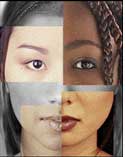I am a biological anthropologist and one of my favorite classes to teach is about modern human variation. I ask my undergraduates to line up in front of the class according to their height. They have done this since kindergarten and so it is fairly easy and banal. Then I give them other categories (with the caveat that they are free to opt out at any time), such as: skin color, eye color, hairiness, weight, intelligence, gender, sexuality, and attractiveness. As the categories progress the line-ups get more difficult to make. Students start opting out and becoming very uncomfortable. I have yet to have a class line-up according to attractiveness.
The whole point of this exercise is to make students aware of the interaction between culture and biology. Despite all of those categories being definable as “biological” the social and cultural presumptions about race, body size, gender, sexuality, intelligence and attractiveness lend an emotional weight to these traits that height or eye-color does not have. Afterwards, we always have an enlightening discussion about human variation and culture. Why is it socially inappropriate to line-up by some variables and others not? How much of what we think is biological is really culturally constructed? Why and how do moral notions of good/bad get attached to some traits and not others? I explain that the often illusive concept of culture can be understood as all the extra baggage attached to the latter categories.
I cannot help but wonder if this exercise can be applied in other settings. Join me in a mental experiment to conduct a virtual Mormon women’s line-up.
- What if we took all of the women in our wards and asked them to line up by the typically LDS prestige granting/limiting categories of: temple worthy, calling, spouse’s calling, marital status, SAHM vs. working mom, number of kids, and number of RM, married in the temple, active kids, etc.? Imagine what that line up would look like and the emotional weight of some of those categories.
- What would happen if we had that group line up based on the level of agency vs obedience they used to decide major life decisions: when and whom to marry, if and how many kids to have, career choice, political decisions, following the Word of Wisdom, tattoos, earrings, clothing choices, church attendance, supporting the church’s stances on the ERA, abortion, homosexuality and gay marriage, etc? Assuming we could make everyone honest, how radical would the conversation after that line-up be?
- What if we had that same group line up by stereotypically “worldly” prestige granting/limiting categories: education level, occupation, salary, number of people you supervise, SAHM vs. working mom, body size, breast size, and house size, etc.? Imagine what that line up would look like and the cultural presumptions of some of those categories.
- Now imagine that same group lining up via less objective categories; traits that we are taught regularly are “natural” and inherent rather than on a continuum of variation: nurturing, protectiveness, ambition, kindness, cleanliness, and sex drive, etc.? What would that line up look like? Would all of the women be gathered on one side? Divided into two separate groups? Or would there be a continuum just like there are for other personality-based traits?
What did you learn from this mental exercise?
I learned:
- Much of the emotional weight, baggage, and pain of the line-up activity came in categories where I imagined people lining up dependent on someone else: marital status, a spouse’s calling/job, children’s activity in the church, etc.
- I would love to have a radically honest conversation with LDS women about the motivations (obedience vs agency) behind people’s major life decisions.
- The negative emotional weight of the category, SAHM vs working mom, was completely dependent on whether the line-up was based on LDS or worldly prestige. Sadly, the antagonism that many SAHM’s feel in the world is transferred to working moms in the church.
- There are not “natural” abilities or characteristics for all women. There is more variation within a gender than between them. Women fall at each end of the bell curve for any category and it is illogical and even damaging to deny people that variation.
What other categories or line-ups would you have created? How does this exercise help us to see cultural baggage? How much “variation” do you think we really have amongst LDS women and/or how much is allowable, hidden, ignored or denied? Where do you fit on all these line-ups? How did that make you feel?







4 Responses
Actually the women in my ward DID divide by breast size one time. It was not an official church activity, but everyone there was a woman from my ward (I was not in attendance — I heard about it). They had to form two teams, and someone had the idea of big v. little. So women with very large breasts and very small breasts immediately segregated, and then they past judgement on the middle ground ones to put them in teams. I gather it was in the spirit of fun — ish but I admit I am glad I was not there. I realize that isn’t your point, but it made me think of it.
Fascinating!! Here’s what I take away from this mental exercise: after my initial discomfort with overtly categorizing people in this way, I admitted to myself that I internally put people in these categories all the time. Then I realized how freeing it would be to just stop doing this! Thanks for the insights from the OP.
(p.s. I think the example of “bigs” vs. “littles” is hilarious! There’s no need to take ourselves too seriously.)
Whoa-man,
Thank you for this window into your biological anthropological world. This is so interesting. Like you say at the end of your post, I too think there is probably a lot more variation within our gender that typical Mormon rhetoric implies. I would just love it if women could be vulnerable and open in Relief Society. It happens sometimes, but not enough. For example, I remember a moment when a young married woman moved into the ward and in one of her first RS lessons, she admitted that she loved coffee and wasn’t drinking it at the moment, but probably would sometime in the future. She was pretty funny about it too. I loved that! That took some courage. If only more Mormon women were willing to lay themselves open and talk about their unique qualities and challenges.
Wow! What an interesting idea! I have to admit that, as a man, I would be curious about what the distributions would look like on some of those variables if you added men to the mix. For one thing, it would sure show some good evidence that a lot of how we sometimes imagine women and men being completely different is bunk. 🙂